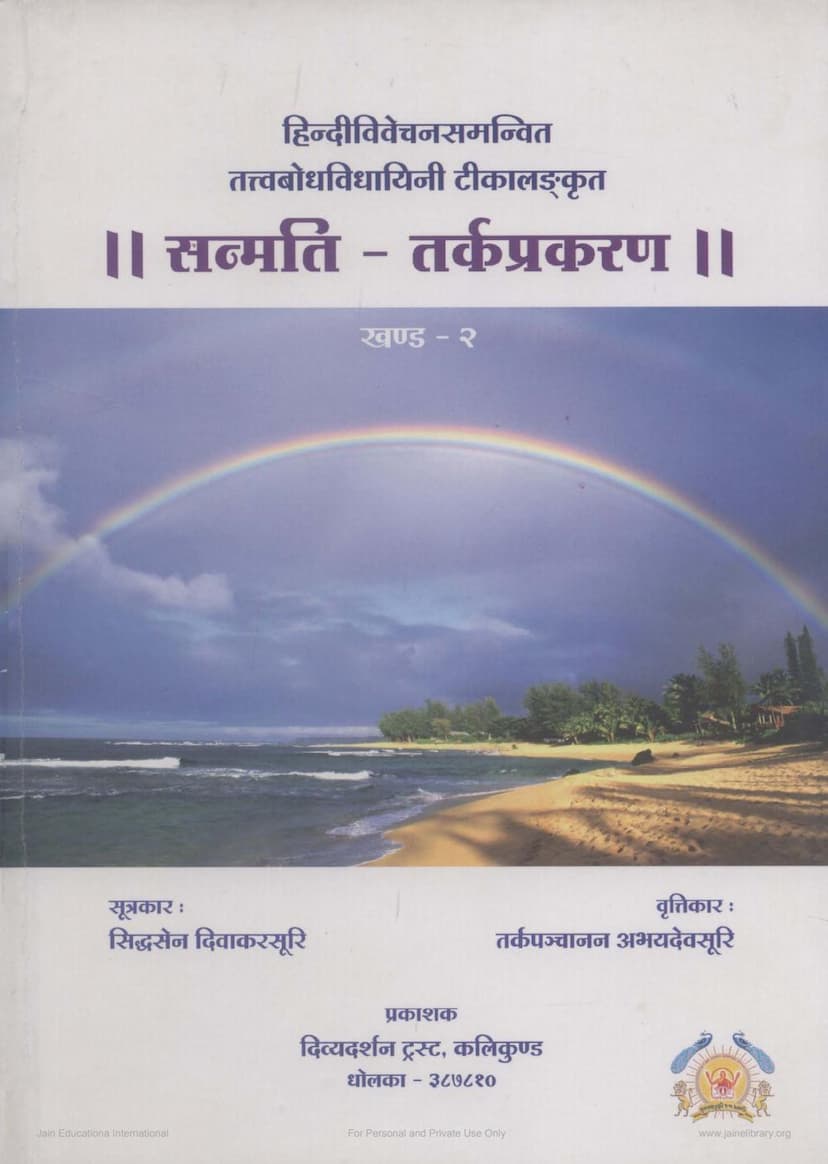Sanmati Tark Prakaran Part 02
Added to library: September 2, 2025

Summary
Sanmati Tark Prakaran Part 02: A Comprehensive Summary
This document is the second part of the "Sanmati Tark Prakaran," a significant Jain text authored by Siddhasena Divakarasuri and commented upon by Abhaydevsuri. The work, published by Divya Darshan Trust, is presented here with a Hindi commentary by Acharya Jayasundar Suri. This volume focuses on the second, third, and fourth gathas (verses) of the original text.
Core Themes and Content:
The Sanmati Tark Prakaran is a foundational text in Jain logic and epistemology. This second volume delves into complex philosophical arguments, primarily focusing on:
- The Nature of Reality and Language: A significant portion of the text grapples with the relationship between words and their meanings. It extensively critiques various theories of language and meaning, particularly the Buddhist "Apoha" (exclusionary) theory, which posits that words signify negation or exclusion of other things rather than positive affirmation. The text argues for a more nuanced understanding of language and meaning, rooted in the Jain philosophy of Anekantavada (non-absolutism).
- Theories of Meaning (Śabdārtha Mīmāṁsā): The work examines and refutes several philosophical positions regarding what constitutes the meaning of a word. It discusses and critiques theories that propose the meaning to be:
- The "Asti-artha" (Existing Entity): The idea that words directly refer to existent entities.
- The "Samudaya-artha" (Collective Meaning): The notion that words refer to a collection of parts or attributes.
- The "Abhijalpa-artha" (The Indescribable): The concept that meaning is ultimately indescribable or beyond conceptualization.
- The "Buddhyāruḍha-ākāra-artha" (The Mental Image): The view that meaning resides in the mental image or conceptual form of an object.
- The "Pratibhā-artha" (Apprehension/Illumination): The idea that meaning arises from an intuitive apprehension.
- The "Anyāpoha" (Exclusion): The Buddhist theory that words signify what they are not. The text meticulously analyzes these viewpoints, often using logical arguments derived from the Nyaya school of Indian philosophy, while upholding the unique Jain perspective.
- The Role of Nayas (Standpoints): The text explores the concept of nayas (standpoints or perspectives) within Jainism, particularly highlighting the Dravastyika (substance-based) and Paryayastika (mode-based) nayas. It demonstrates how these different standpoints are crucial for understanding the multifaceted nature of reality and how they can be reconciled.
- Critique of Other Philosophical Schools: The Sanmati Tark Prakaran engages in rigorous debate with other contemporary philosophical traditions, including various schools of Buddhism (like the Vaibhashika and Yogachara) and the Mimamsa and Nyaya schools of Brahmanical thought. The refutations are not merely dismissive but involve detailed logical dissection of their core tenets.
- The Importance of Intent (Vivakṣā): The text also touches upon the role of the speaker's intention in conveying meaning, emphasizing that linguistic convention and intended meaning are crucial aspects of communication.
Structure and Argumentation:
The second volume follows the structure laid out by the original gathas. The author, Abhaydevsuri, in his commentary, meticulously explains the nuances of Siddhasena Divakara's terse verses. Acharya Jayasundar Vijay further elucidates these complex arguments through his Hindi commentary, making the profound philosophical discussions accessible. The text employs a dialectical approach, presenting opposing viewpoints (पूर्वपक्ष - purvapakṣa) and then systematically refuting them (उत्तरपक्ष - uttarapakṣa) with logical reasoning and scriptural evidence.
Key Arguments and Concepts Discussed:
- The relationship between words and reality: The text questions whether words directly refer to reality or merely to mental constructs. It explores the concept of saṁketa (convention or designation) and its limitations.
- The critique of negation as sole meaning (Apoha): The text strongly refutes the Buddhist notion that words signify only by way of negation. It argues that language has a positive referential capacity rooted in convention and the speaker's intent, within the framework of Anekantavada.
- The nature of substance (Dravya) and mode (Paryaya): The distinction between the eternal substance and its changing modes is explored, and how both are real and apprehended through different standpoints (nayas).
- The criticism of eternalism and nihilism: The text challenges theories that posit an eternally existing, unchanging reality (like the eternal soul in some Brahmanical schools) and theories that deny any ultimate reality or permanence (like some Buddhist schools).
- The role of knowledge and perception: The text discusses the nature of valid knowledge (pramāṇa) and perception (pratyakṣa), emphasizing that knowledge is often a construct influenced by mental factors (vikalpa) and conventional understanding (saṁvṛti) without negating the ultimate reality of dravya.
Significance:
The Sanmati Tark Prakaran is a cornerstone of Jain epistemology and logic. This volume, with its detailed commentary, provides invaluable insights into the sophisticated analytical tools and philosophical depth of Jain thinkers. It showcases the Jain tradition's engagement with broader Indian philosophical discourse and its unique contributions to understanding the complexities of reality, language, and knowledge.
Note: This summary is based on the provided pages which offer an introduction to the text, its lineage, and a detailed breakdown of the topics covered in the second volume, particularly the extensive debate on the nature of words and their meanings (Apoha theory). The catalog link and the table of contents within the provided pages suggest a vast scope of topics discussed within the entire work.